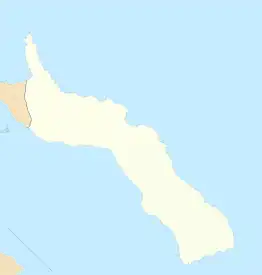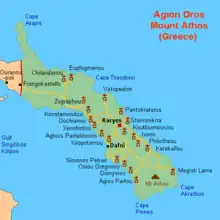Latin: Sancte Marie Cenobii Amalfitanorum
Greek: Μονή των Αμαλφηνών | |
 Location within Mount Athos  Amalfinon Monastery (Greece) | |
| Monastery information | |
|---|---|
| Full name | Monastery of the Holy Virgin Mary (Amalfinon) |
| Order | Rule of Saint Benedict |
| Established | between 985-990 AD |
| Dedicated to | The Blessed Virgin Mary |
| People | |
| Founder(s) | Leo the Roman |
| Site | |
| Coordinates | 40°12′15″N 24°20′17″E / 40.2042°N 24.338°E |
The Amalfinon Monastery[1] (Greek: Μονή των Αμαλφηνών) or Amalfion was the most prominent of the three former monasteries for Latin-speaking Christians on Mount Athos before the Great Schism. Sometimes described one of the first examples of Western Rite Orthodoxy after the events of 1054, its affiliation with either Eastern Orthodox Church or the Catholic Church has been subject of debate.[2][3] It was located halfway between the Athonite monasteries of Great Lavra and Karakallou Monastery.
History
Amalfinon was founded in the 10th century by monks from Amalfi, Italy.[4] They followed the Rule of Saint Benedict and used Latin as their liturgical language.
The monastery was built between the years 985 and 990 by 7 Benedictine monks under the leadership of Leo the Elder, who was invited to build the monastic community by the Georgian Orthodox at the Iviron Monastery.[5] The earliest Benedictine monastics associated with Amalfinon were close friends with Saint Athanasius of Athos, the founder of the Great Lavra.[6] By the 12th century the Amalfinon Monastery, remaining loyal to Eastern Orthodoxy,[7][8] flourished and was held in high esteem. Records on Mount Athos show that the Abbot of Amalfinon signed, in Latin, under the signature of the Abbot of the Great Lavra.
The monastery was peacefully transferred to the Great Lavra in 1287 after suffering greatly from crusaders and being unable to repair the monastery buildings and replace monastics and clergy.[9][10] The Holy Monastery of Amalfinon was turned over by Byzantine emperor Adronikos II Palaiologos to the hands of the Great Lavra Monastery.[11]
The area surrounding the site, now called Morfonos or Amalfinos, as well as the ruins themselves, owe their names to the Monastery of Amalfinon, which was also called Morfonos.[11] There are 5 monks of the Great Lavra tending the land around the area of Morfonos.
The monastery remained active until the 13th century, after the Great Schism in 1054. The area is still called Morfonos or Morfonou in Greek.
Affiliation of the monastery
The affiliation of the Monastery of Amalfinon and its maintenance of Latin liturgical rites after the Great Schism have sometimes seen it described as one of the earliest examples of Western Rite Orthodoxy.[12][13] It has been suggested by some, such as Elene Metreveli, that the monastery was affiliated with the Catholic Church after the East-West Schism.[14] However, multiple ecclesiastical Eastern Orthodox scholars believe the praxis of Amalfi to have remained aligned with Eastern Orthodoxy and have pointed out that expulsions of Latin Christians from Eastern Orthodox territory had occurred before, such as the expulsion of Frankish monks from the Mount of Olives in 808 for using the filioque in the Creed, or the complete expulsion of all Latins from Constantinople in 1186.[11] Amalfinon, remaining loyal to Eastern Orthodoxy, flourished and was supported by Athos and the Byzantines long after the schism, rising to the rank of 2nd signatory after the Great Lavra. [15]
Notable monastics
List of monks and abbots of, or connected with, Amalfion:[16]
- John and Arsenius, c. 984
- Elder Leo the Roman, founder of the monastery with six disciples and help from the Georgians of Iviron, c. 985-990
- John of Benevento of the monastery of Monte Cassino, c. 986-993
- Abbot John III of Cassino, c. 986-993
- Abbot John the Amalfitan and successors, c. 991-1035. It is unknown if all the signatories on the Athonite charters and registers from 991-1035 were the same Abbot John of Amalfitan or if there were multiple Abbots with the same name. In 1017, Abbot John signs 2nd in rank.
- Abbot Benedict, now signing under Byzantine Imperial Patronage, 1081
- Abbot Demetrius, Hegumen, 1083
- Abbot Vito, 1087-1108
- Abbot Manso or Mauro, 1169
See also
References
- ↑ John. "Amalfion Benedictine Monastery on Mount Athos". Retrieved 2022-06-03.
- ↑ Macharashvili, George (15 April 2013). "Religious Affiliation of the Benedictine monks of Mount Athos". Spekali.
- ↑ Aidan Keller, Amalfinon: The Western rite monastery of Mt Athos (2002) p. 11
- ↑ Papathanassiou, Manolis. "Tower of Morfonou". Καστρολόγος. Retrieved 2022-06-03.
- ↑ "The Benedictine Monastery of Saint Mary on Mount Athos".
- ↑ "Benedictine Monastery on Mount Athos?". 28 November 2019.
- ↑ Macharashvili, George (15 April 2013). "Religious Affiliation of the Benedictine monks of Mount Athos". Spekali.
- ↑ "О конфессиональной принадлежности афонских бенедиктинцев - Афонит".
- ↑ "Benedictine Monastery on Mount Athos?". 28 November 2019.
- ↑ Aidan Keller, Amalfinon: The Western rite monastery of Mt Athos (2002) p. 14
- 1 2 3 Nichiporuk, Reader John (2019-11-28). "Benedictine Monastery on Mount Athos?". The Catalog of Good Deeds. Retrieved 2022-06-03.
- ↑ "О конфессиональной принадлежности афонских бенедиктинцев - Афонит".
- ↑ Macharashvili, George (15 April 2013). "Religious Affiliation of the Benedictine monks of Mount Athos". Spekali.
- ↑ Macharashvili, George (2013-04-15). "Religious Affiliation of the Benedictine monks of Mount Athos". Spekali. ISSN 1987-8583.
- ↑ Aidan Keller, Amalfinon: The Western rite monastery of Mt Athos (2002) p. 12
- ↑ Aidan Keller (2002). Amalfinon: The Western rite monastery of Mt Athos.
External links
- Aidan Keller, Amalfinon: The Western rite monastery of Mt Athos
- The Benedictine Monastery of Saint Mary on Mount Athos
- О конфессиональной принадлежности афонских бенедиктинцев
- Амальфион: тайны и загадки бенедиктинского монастыря на Афоне
- Benedictine Monastery on Mount Athos (Saint Elizabeth Convent)
- Peer Reviewed Assessment of the Religious Affiliation of the Benedictine monks of Mount Athos and their adherence to Greek Orthodoxy from Tbilisi State University
- Saint Benedict on Mount Athos
